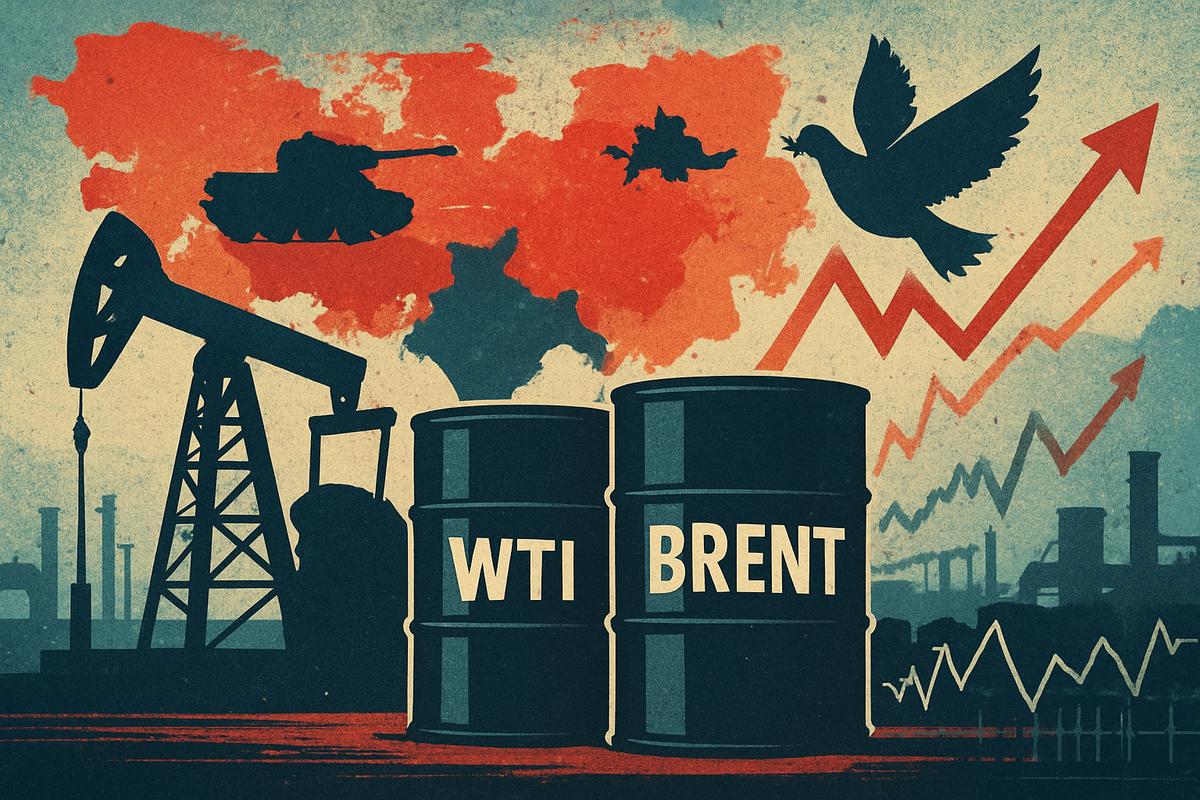
Global crude oil markets are navigating a treacherous landscape as of November 3, 2025, caught between persistent geopolitical tensions and the strategic maneuvers of OPEC+. Both West Texas Intermediate (WTI) and Brent crude futures are experiencing significant volatility, reflecting a market grappling with an anticipated oversupply even as critical supply routes and major producers face ongoing threats.
The immediate implications are a delicate balancing act for crude prices. While U.S. and allied sanctions on Russia, coupled with Ukrainian drone strikes on Russian energy infrastructure, introduce substantial supply-side risks, a looming global oil surplus and a cautious OPEC+ strategy are exerting downward pressure. This dynamic equilibrium has resulted in Brent crude trading in the range of $64.53-$65.24 per barrel and WTI crude between $60.67-$61.43 per barrel, with prices showing modest rebounds after recent OPEC+ decisions, yet remaining sensitive to fresh geopolitical developments.
A Volatile Brew: Sanctions, Strikes, and Strategic Pauses
The current state of crude oil markets is a direct consequence of a series of impactful events and long-standing geopolitical flashpoints. A recent timeline highlights the escalating pressures:
October 2025: The U.S. Treasury Department imposed comprehensive sanctions on Russia's two largest oil companies, Rosneft and Lukoil, with a critical deadline of November 21, 2025, for foreign companies to cease transactions. Britain also sanctioned Russia's two largest refineries. These measures aim to cripple Russia's ability to fund its military operations, leading to significant logistical and financial challenges in the energy sector. Following these sanctions, Brent crude prices initially surged by 5% to 9%, peaking above $67, while WTI also rose above $60.
November 2, 2025: A large-scale Ukrainian drone strike reportedly set an oil tanker ablaze and damaged key export terminals near Tuapse, a major Russian Black Sea oil port. This attack underscores the direct threat to vital energy infrastructure, further jeopardizing Russian refined fuel exports, which have already seen a sharp decline due to Western sanctions and successful Ukrainian strikes.
November 2-3, 2025: OPEC+ announced a modest increase of 137,000 barrels per day (bpd) for December, maintaining the pace from October and November. Crucially, the alliance decided to pause any further production increases for the first quarter of 2026 (January, February, and March). This pause is a proactive measure to stabilize market sentiment and avert an anticipated oversupply during a period of seasonally weak demand. Despite the decision, market reactions were largely muted, with prices seeing only a modest rebound as fears of a global oil surplus and weak manufacturing data in Asia continued to weigh on sentiment.
Key Players and Stakeholders: The OPEC+ alliance, led by Saudi Arabia and Russia, remains a central figure, its production decisions directly impacting global supply. The United States wields significant influence through sanctions and its domestic shale production. Russia and Ukraine are in direct conflict, with Ukraine's military actions directly threatening Russian energy infrastructure. Houthi rebels in Yemen continue to disrupt Red Sea shipping, while tensions involving Iran and the broader Middle East add layers of instability. Venezuela's (PDVSA) oil production remains a wildcard, influenced by U.S. sanctions, and Libya's (National Oil Corporation) efforts to increase output contribute to the global supply picture.
The new U.S. sanctions on Russian entities have already led to significant shifts in global oil trade, with Chinese refiners like Sinopec (SHA: 600028) and PetroChina (SHA: 601857), along with Indian refineries, reducing their imports of Russian oil. This redirection of approximately 400,000 bpd of Russia's exports to China creates considerable uncertainty regarding the overall stability and volume of global oil supply, even as overall oversupply concerns persist, with projections for a 2026 surplus ranging widely from 190,000 bpd to 4 million bpd.
Winners and Losers in a Volatile Market
Fluctuating WTI and Brent crude prices due to geopolitical tensions create a clear divide between potential winners and losers among public companies.
Potential Winners from Rising Crude Oil Prices:
- Upstream Oil & Gas Exploration & Production (E&P) Companies: These companies directly benefit from higher crude prices, which boost their revenues and profit margins. Increased prices also make previously uneconomical reserves profitable, incentivizing more exploration and drilling. Examples include ExxonMobil (NYSE: XOM), Chevron (NYSE: CVX), ConocoPhillips (NYSE: COP), Occidental Petroleum (NYSE: OXY), and Canadian Natural Resources (TSX: CNQ). Indian players like ONGC (NSE: ONGC) and Oil India Ltd (NSE: OIL) also see direct benefits.
- Oilfield Services Companies: As E&P companies become more profitable, they increase capital expenditure on drilling and production, leading to greater demand for services. Major beneficiaries include Halliburton (NYSE: HAL) and Schlumberger (NYSE: SLB).
- Renewable Energy Companies: Persistently high crude prices make renewable energy sources more economically competitive, accelerating investment and adoption. Companies like Adani Green Energy (NSE: ADANIGREEN) and Suzlon Energy (NSE: SUZLON) could see increased demand for their solutions.
Potential Losers from Rising Crude Oil Prices:
- Airlines/Aviation Industry: Jet fuel is a primary operating cost for airlines. Rising crude prices directly increase fuel expenses, eroding profit margins. While airlines may try to pass on costs, it can dampen consumer demand. Major carriers like American Airlines (NASDAQ: AAL), United Airlines (NASDAQ: UAL), Delta Air Lines (NYSE: DAL), and Southwest Airlines (NYSE: LUV) face significant cost pressures.
- Transportation and Logistics Companies: Fuel is a substantial portion of operational expenses for trucking, shipping, and railway companies. Higher crude prices translate to increased fuel costs, reducing profitability, especially for truckload carriers and shipping companies.
- Chemical Industry: Crude oil is a fundamental feedstock for petrochemicals, which are essential raw materials. Rising crude prices directly increase the cost of these key starting materials (KSMs), leading to higher production costs and margin erosion for commodity chemical producers. Companies like Aarti Industries Ltd (NSE: AARTIIND) and Deepak Nitrite Ltd (NSE: DEEPAKNITR) are particularly vulnerable.
- Manufacturing Firms (General): Any manufacturing company reliant on petroleum-derived inputs or extensive transportation will see increased operational costs, affecting profitability.
Companies with Mixed or Nuanced Impact:
- Refiners (Downstream Oil & Gas Companies): Their profitability depends on the "crack spread" (refining margin). While higher crude prices increase feedstock costs, margins can expand if refined product prices rise even faster. Companies like Valero Energy (NYSE: VLO) and Phillips 66 (NYSE: PSX) are sensitive to these dynamics.
- Integrated Oil Companies: Giants like ExxonMobil (NYSE: XOM), Chevron (NYSE: CVX), Shell (NYSE: SHEL), BP (NYSE: BP), and TotalEnergies (NYSE: TTE) have diversified operations. Their upstream segments benefit from higher prices, but downstream refining might face pressure. Overall profitability hinges on the relative performance of these segments.
Broader Implications: A Shifting Energy Paradigm
The current crude oil price volatility, driven by geopolitical tensions, is not an isolated event but rather a symptom of deeper, evolving industry trends with far-reaching ripple effects.
This volatility fits into a broader narrative of a supply-led surplus in the global oil market, even as geopolitical events threaten to disrupt supply. Global crude oil inventories reached a four-year high in August 2025, with non-OPEC+ producers like the United States, Brazil, Canada, Guyana, and Argentina contributing to surging global supply. Simultaneously, global oil demand growth is forecast to be the lowest since 2009 (excluding 2020), impacted by a "harsher macro climate" and an accelerating energy transition. Strong refining margins are currently acting as a crucial stabilizer, preventing a sharper price decline, but this highlights the market's vulnerability to downstream disruptions.
Ripple Effects: The impact extends beyond direct competitors. Oil-importing nations benefit from lower crude prices but face heightened supply security risks and increased import costs if geopolitical tensions escalate. Oil-exporting nations, conversely, experience economic challenges from lower prices and oversupply, straining national budgets. Globally, heightened geopolitical tensions act as a negative demand shock, increasing uncertainty and potentially disrupting international trade.
Regulatory and Policy Implications: Governments are increasingly intervening in energy markets, prioritizing economic security over efficiency. Sanctions and trade policies, like the tightened U.S. sanctions on Russian energy exports, are direct tools influencing supply. OPEC+ production management strategies, such as the planned freeze in Q1 2026, aim to stabilize the market. Furthermore, climate policies and their inherent uncertainty significantly impact crude oil markets, driving investment in cleaner energy sources and affecting long-term oil demand. Some countries, like China, use domestic price regulations as a "shock absorber" to shield their economies from global crude price volatility.
Historical Precedents: History offers numerous examples of geopolitical events triggering crude oil price volatility. The 1970s oil crises, the Gulf War (1990-1991), and the Russian invasion of Ukraine in 2022 all demonstrated how geopolitical shocks can lead to sharp price surges through supply disruptions. However, the market's response is not always linear, often showing resilience and a tendency for recovery if broader economic impacts are contained, as seen after the 9/11 attacks and the Israel attacks in October 2023. The mid-2010s price war also serves as a precedent for potential market gluts and price declines.
What Comes Next: Navigating Uncertainty
The future trajectory of WTI and Brent crude prices is poised for continued uncertainty, influenced by an intricate dance between underlying market fundamentals and unpredictable geopolitical events.
Short-Term Possibilities (Next 6-12 Months): The immediate outlook, through late 2025 and into early 2026, is largely dominated by an anticipated oversupply. Robust increases in global supply, particularly from non-OPEC+ nations like the United States, Brazil, and Guyana, are expected to outpace moderating global demand. The U.S. Energy Information Administration (EIA) forecasts Brent crude could fall to an average of $59 per barrel in Q4 2025 and potentially reach $49 per barrel by March-April 2026, with WTI following suit. OPEC+'s decision to pause production increases for Q1 2026 is a strategic move to manage this surplus, but its effectiveness against a backdrop of surging non-OPEC+ output remains to be seen.
Long-Term Possibilities (Beyond 1 Year): The long-term outlook (2026-2030 and beyond) points towards deepening oversupply concerns and the accelerating impact of the energy transition. The World Bank projects global commodity prices, including oil, to fall to a six-year low in 2026, with Brent potentially averaging $60. Some analysts even warn of a record surplus by 2026, potentially driving WTI to as low as $35 a barrel. The International Energy Agency (IEA) forecasts global oil demand to plateau around 105.5 million bpd by 2030, driven by surging electric vehicle sales and efficiency gains, signaling a long-term shift away from fossil fuels. Global oil production capacity is projected to outpace demand, reaching 114.7 million bpd by 2030, further contributing to a comfortably supplied market in the absence of major disruptions.
Potential Strategic Pivots:
- OPEC+ will likely continue its delicate balancing act, employing output adjustments to maintain market stability.
- Non-OPEC Producers will remain significant supply sources, though sustained low prices could eventually curb growth in U.S. shale.
- Consuming Nations will prioritize energy resilience and diversification, as seen with India's efforts to diversify crude imports.
- Energy Companies are expected to focus on cost efficiency, portfolio optimization, and robust hedging strategies, while also exploring diversification into energy storage, carbon capture, and green hydrogen.
Market Opportunities and Challenges: Opportunities include expanded market share for non-sanctioned producers, growth in energy transition technologies, and emerging market demand, particularly from India. Challenges encompass persistent oversupply, the unpredictable geopolitical risk premium, demand headwinds from a slower global economic recovery, and inflationary pressures. The refining sector also faces potential strain from excess capacity by 2030.
Possible Scenarios and Outcomes:
- "Oversupply Crash" Scenario: A significant and prolonged decline in WTI and Brent prices (potentially to $35-$50 in 2026) if non-OPEC+ production continues to surge and demand remains subdued.
- "Geopolitical Spike" Scenario: Sudden, sharp, but likely temporary, price increases due to a major escalation in any of the current geopolitical flashpoints.
- "Managed Volatility" Scenario: WTI and Brent prices remain volatile but largely range-bound ($60-$80) due to OPEC+'s adaptive approach, with temporary excursions driven by events.
- "Accelerated Transition" Scenario: An earlier and steeper peak in global oil demand due to stronger-than-anticipated adoption of clean energy, leading to sustained downward pressure on prices beyond 2030.
Comprehensive Wrap-Up: A Market in Flux
As of November 3, 2025, the crude oil market is defined by a profound tug-of-war between fundamental oversupply and an ever-present geopolitical risk premium. OPEC+'s strategic decision to pause production increases for Q1 2026 underscores its commitment to market stability, yet it operates within a fragile environment where the full impact of U.S. sanctions on Russian oil and ongoing conflicts in the Black Sea and Middle East remains uncertain.
Key Takeaways: The market has largely priced in OPEC+'s modest December increase, but concerns about a significant 2026 surplus loom large. While the "geopolitical risk premium" has shown signs of dissipating, concrete events like drone strikes and sanctions can quickly reignite it. Current prices reflect a cautious recovery from multi-month lows, yet analysts warn of their fragility against the backdrop of record U.S. crude oil production and diverging views on future demand growth.
Assessment of the Market Moving Forward: The market will likely be characterized by continued volatility. OPEC+'s flexible strategy is crucial, but its ability to counter a substantial supply glut from non-OPEC+ producers will be continuously tested. The geopolitical landscape ensures that sudden supply disruptions remain a potent threat, capable of triggering rapid, albeit potentially temporary, price rallies. The long-term outlook is increasingly shaped by the accelerating energy transition, which is expected to cap demand growth and exert downward pressure on prices beyond 2030.
Lasting Impact: The ongoing geopolitical tensions are not just causing short-term price fluctuations; they are fundamentally reshaping global oil trade routes, prompting diversification strategies among importing nations, and accelerating the push towards energy independence and cleaner alternatives. The resilience of the U.S. shale industry and the strategic discipline of OPEC+ will be critical factors in determining the market's stability in the coming years.
What Investors Should Watch For: Investors should closely monitor OPEC+ decisions, particularly their adjustments beyond Q1 2026. Global demand indicators, especially from China and other Asian economies, will be crucial. Geopolitical developments in Ukraine, the Middle East, and Venezuela remain "wild cards" that could trigger rapid price revaluations. Additionally, tracking global crude oil inventory levels, U.S. production trends, and the dynamics of the Brent forward curve will provide vital insights into market sentiment and underlying supply-demand balances.
This content is intended for informational purposes only and is not financial advice





